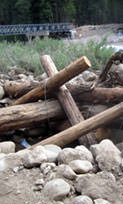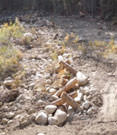
Over seventy-five years ago, a 50-year flood event along the south fork of the Kings River within Kings Canyon National Park would have been approximately 260-feet wide, filling the entire channel from bank to bank up to an elevation of approximately 4,600 feet. Then came the Cedar Grove Bridge.
To minimize the size of the bridge in 1939, earthen embankments extended into the river channel. This narrowed the river's floodway to approximately 137 feet. In addition, a pier was constructed in the middle of the channel, resulting in another impediment to free flow, particularly for large trees. Then came the floods.
Major floods in 1955 and 1997 created a side channel that continually threatened the stability of the bridge. Transportation professionals envisioned a much longer, modernized bridge, but an equally competing priority was the reestablishment of the riverbank. The area surrounding the river required re-contouring and installation of appropriate vegetation and erosion control structures in conjunction with the bridge reconstruction in order to restore the historic and natural floodplain conditions.

Engineered logjams are a modern take on a natural solution. The engineered log jams mimic the natural process where fallen trees become caught on the embankment and then accumulate sediment and cause other material build up adjacent to the structure. Naturally occurring logjams have historically been removed to assist in navigation or for flood control purposes, while not accounting for the benefits of the system. Engineered logjams can provide the bank protection desired while maintaining navigation and flood conveyance.
In addition, the logjams can integrate fish habitat restoration with bank protection. The Kings River restoration project represents one of the largest national projects using engineered logjams.
Engineers replicated nature by creating structures approximately 25-feet square along the bank. The logs are embedded in a truss-like arrangement and secured in place. A flow directs log angles and extends into the main channel flow to direct flow away from the newly constructed bank and bridge abutment. Excavated gravel bar alluvium, boulders and native material are used to fill the voids within the structure and are then planted with native willows, cottonwood, conifers and other native floodplain vegetation that will form a mature riparian buffer over time.
Where material is available, engineered logjams can provide an aesthetic, natural looking space to prevent erosion and enhance bank stability. Costs for installing engineered logjams are site-specific and are affected primarily by availability of wood materials, dewatering capabilities, and equipment access. The use of engineered logjams provides a natural and sustainable solution that is cost effective.
Next Up:
43 Days and Counting: Expedited Rebuild of a Century-Old Bridge →